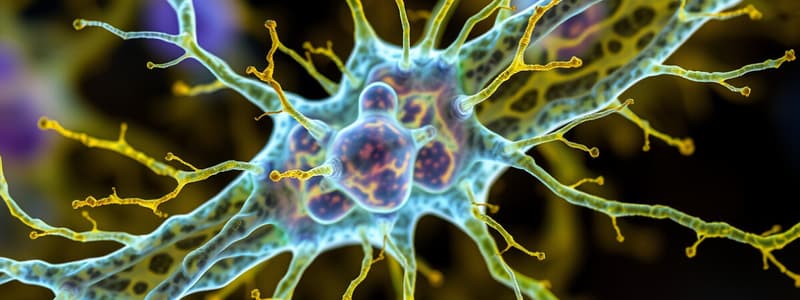Podcast
Questions and Answers
What is the primary role of the cytoskeleton in a cell?
What is the primary role of the cytoskeleton in a cell?
- Synthesizing genetic material
- Regulating the cell's metabolic rate
- Facilitating hormone receptor activity
- Determining the shape and providing structural support (correct)
Which of the following proteins is primarily associated with microfilaments?
Which of the following proteins is primarily associated with microfilaments?
- Myosin
- Keratin
- Tubulin
- Actin (correct)
How do microtubules contribute to cell division?
How do microtubules contribute to cell division?
- By forming contractile structures
- By creating the mitotic spindle for chromosome segregation (correct)
- By participating in the synthesis of DNA
- By facilitating endocytosis
Ectoplasm is best described as which part of the cytoplasm?
Ectoplasm is best described as which part of the cytoplasm?
Which statement accurately describes structural proteins compared to functional proteins?
Which statement accurately describes structural proteins compared to functional proteins?
What are intermediate filaments primarily composed of?
What are intermediate filaments primarily composed of?
What is the function of actin in muscle contraction?
What is the function of actin in muscle contraction?
Which of the following best explains the term 'cytokinesis'?
Which of the following best explains the term 'cytokinesis'?
What role do microtubules play in forming cilia and flagella?
What role do microtubules play in forming cilia and flagella?
What distinguishes structural proteins from functional proteins in a cell?
What distinguishes structural proteins from functional proteins in a cell?
Study Notes
Cytoskeleton Overview
- Cytoskeleton: A structural framework within cells, crucial for maintaining cell shape and integrity.
- Composed of proteins, specifically structural proteins synthesized by ribosomes.
Composition and Function
- Most abundant cellular component: Water, except in fat cells where fat predominates.
- Second most abundant component: Proteins, classified into structural (immobile) and functional (mobile) proteins.
- Functions include:
- Determining cell shape and contour.
- Assisting in cell division (cytokinesis) and organelle movement.
Components of the Cytoskeleton
- Actin filaments located in the ectoplasm (outer part of the cytoplasm) provide structural support for the plasma membrane.
- Other components include:
- Myosin: A functional protein involved in muscle contraction.
- Tubulin: Forms microtubules essential for cellular structure and function.
Roles in Cellular Processes
- Cytoskeleton provides tracks for organelle movement, aiding in functions like muscle contraction and cytokinesis.
- Contributes to cell signaling pathways and the segregation of chromosomes during cell division via the mitotic spindle.
Types of Cytoskeleton
- Three primary types in eukaryotic cells:
- Microfilaments: Composed of actin, involved in muscle contraction and cell movement.
- Microtubules: Formed from tubulin, essential for cilia and flagella formation.
- Intermediate filaments: Composed of various proteins depending on the tissue type.
Key Terminology
- Cytokinesis: The movement and division of the cytoplasm during cell division.
- Ectoplasm: The outer region of the cytoplasm, providing structural support.
- Mitotic spindle: Structure formed by the cytoskeleton to separate chromosomes during division.
Additional Facts
- Proteins in the cytoskeleton often have the suffix "in," indicating their nature, such as actin, myosin, and tubulin.
- The ability of cells to contract and move relates directly to the function of the cytoskeleton.
Studying That Suits You
Use AI to generate personalized quizzes and flashcards to suit your learning preferences.
Description
Explore the fascinating world of the cytoskeleton and its critical role in cellular structure and function. This quiz will test your knowledge on the different types of proteins in cells, including structural and functional proteins. Get ready to deepen your understanding of cell biology!


